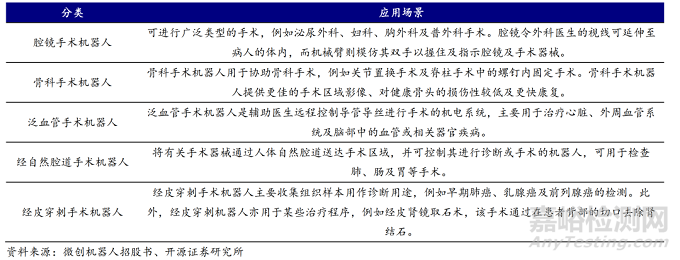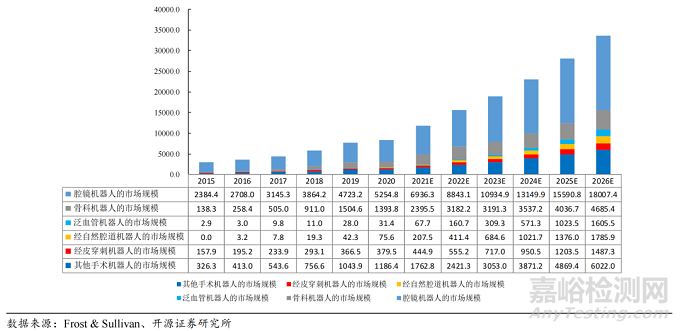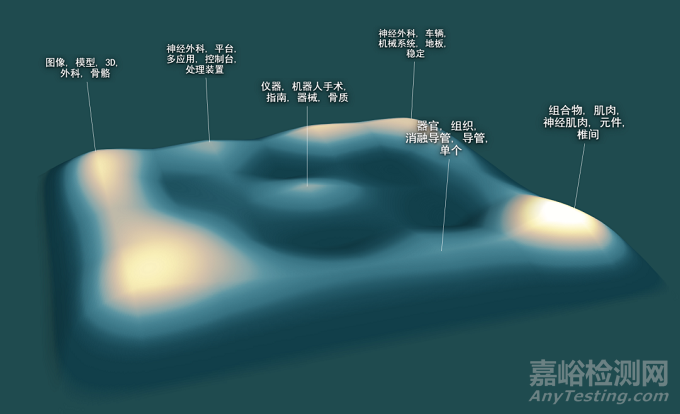您当前的位置:检测资讯 > 科研开发
嘉峪检测网 2022-06-27 21:18
前言导读
手术机器人是一种先进的医疗设备,借助微创伤手术及相关底层技术的发展而发明。手术机器人被用于在高于人类能力的微创伤手术领域中实现高于人类能力的对手术器械的精准操控。手术机器人通常由手术控制台、配备机械臂的手术车及视像系统组成。外科医生坐在手术控制台,观看由放置在患者体内腔镜传输的手术区域三维影像,并操控机械臂的移动,以及该机械臂附带的手术器械及腔镜。机械臂模拟人类的手臂,为外科医生提供一系列模拟人体手腕的动作,同时过滤人手本身的震颤。
机器人手术系统是集多项现代高科技手段于一体的综合体,其用途广泛,在临床上外科上有大量的应用。外科医生可以远离手术台操纵机器进行手术,完全不同于传统的手术概念,在世界微创外科领域是当之无愧的革命性外科手术工具。
经过数十年发展,手术机器人现在主要用于五个快速增长的主要外科领域,其中的骨科、介入手术机器人是及其重要的一个版块。
手术机器人市场概览
当前,随着人工智能、物联网等新科技的快速渗透,医疗健康正在与机器人全面融合,引领外科技术大变革。手术机器人行业迎来快速发展,赛道火热,备受资本青睐。
根据Frost & Sullivan的统计,2020 年全球机器人手术市场规模为 61 亿美元,预计从 2021 年到 2028 年将以 17.60% 的复合年增长率增长,到 2028 年将达到 222.7 亿美元(折合人民币约为1414亿元)。
我国手术机器人市场发展迅猛,根据Frost & Sullivan的统计,市场规模由2016年的人民币853.6百万元增至2020年的人民币2,934.5百万元,年复合增长率达36.2%,预计2030年中国手术机器人的市场规模将达至人民币58,425.9百万元,年复合增长率为34.9%。
手术机器人是将机器人技术应用在医疗领域,显然的,机器人手术是使用机器人系统完成的外科手术类型,机器人辅助手术的开发旨在克服现有的微创手术程序的局限性,并增强外科医生进行开放手术的能力。
手术机器人集成了医学、材料学、自动控制学、数字图像处理学、生物力学、机器人学等诸多学科为一体的新型交叉科学。一般情况下,从临床医学应用角度可将手术机器人主要分为腔镜手术机器人、骨科手术机器人、泛血管手术机器人、 经自然腔道手术机器人、经皮穿刺手术机器人。
下面两幅附图分别给出了各主要细分手术机器人的应用场景和市场规模情况,供各位读者参考。


笔者认为,随着时间发展,对于国内手术机器人市场而言,各大厂商会面临如下5个方面的竞争,分别为:
1.技术战,入局者众多,内卷严重,而且在技术上目前国外先进巨头具有一定优势,国内厂家只有通过技术上“高人一等”才能“脱颖而出”。
2.临床战,目前手术机器人虽然种类繁多,但是依然是医械法规强监管的产业,且市场受众面以大城市的大医院为主体,在如此众多的品牌上市过程中,临床资源就显得弥足珍贵。
3.融资战,手术机器人是一个多学科高度集中的产品,研发周期长,临床要求高,各方面人力资源也紧张稀缺,必然需要高额的投入,这些都需要大量的资本投入,因此手术机器人的玩法从资本市场来讲其实就是“谁的资本强谁成功率大”。
4.营销战,随着国内、国外厂商的产品逐步上市,需要“卖出去”,也需要市场各群体的认同,更需要占据市场率,因此在众多同类型同适应症的手术机器人中“卖得好”才是各大厂商的终极目标,才是“长久之计”。
5.专利战,专利对于手术机器人而言十分重要,当然也是技术层面的演化,更是各大手术机器人厂商市场角力的重要武器,甚至是“终极核武”,规避设计风险、占据市场率都需要专利的辅助,达芬奇在腔镜机器人领域“叱咤风云”恰恰是得益于专利。
ROSA 初探
ROSA(Robot of Stereotactic Assistant,ROSA)手术机器人是一种新的无框架立体定向手术机器人。
ROSA是由法国Medtech公司研发的新一代多功能手术机器人,自诞生以来就受到众多外科医生的青睐。在2016年时,Zimmer Biomet(捷迈邦美)以不低于1.32亿美元的价格收购了法国手术机器人公司Medtech,拥有了ROSA Brain和ROSA Spine机器人辅助手术平台的所有权。2019年1月,Zimmer Biomet获得FDA批准用于膝关节手术应用的ROSA平台和ROSA One Spine平台,并宣布计划在2019年中期ROSA Knee将正式进入膝关节市场。这一举措使得Zimmer Biomet成为第一个获得脑、脊柱、膝关节三大领域的FDA批准的公司。
捷迈邦美成立于1927年,总部设立在美国印第安纳州华沙镇,是骨骼肌肉保健行业的全球领导者。2002年Dr.Bertin NAHUM 博士创立了MedTech公司,在法国蒙彼利埃小镇,第一代骨科辅助定位系统BRIGIT正式面世。
作为外科手术生态系统的开拓者,捷迈邦美继续投入稳定手技术和人工智能技术的研发;并应用于第三代外科机器人平台,致力将新技术,新平台应用到更多的临床实践中,在神经外科、脊柱外科、骨科领域继续深耕细作促进微创精准医学的发展。
专利分析
众所周知的,ROSA家族共有三兄弟:ROSA Knee、ROSA One Brain、ROSA One Spine,对于ROSA手术机器人相关专利。笔者针对ROSA机器人所涉及的专利情况,进行了检索,其结果进行如下展示:
专利地图
下图给出了ROSA手术机器人相关专利的专利地图情况,从该专利地图可以很明了的得到ROSA手术机器人相关专利的技术分支情况。

上图给出了ROSA手术机器人相关专利的专利地图情况,从该专利地图可以很明了的得到ROSA手术机器人相关专利的技术分支情况。
技术脉络
ROSA Knee是一个机器人平台,旨在协助矫形外科医生进行骨切除,并评估软组织状态,以便在全膝关节置换术中定位植入物。外科医生可以在术前使用手术计划软件来计划植入物的定位和大小。外科医生也可使用 ROSA 膝关节系统内的无图像选项,以实现与基于图像的病例相同的目标。该设备由两个单元组成,分别位于手术台的两侧,分别为:由紧凑的机械臂和触摸屏组成的机器人单元和光学单元和触摸屏。
ROSA One Brain系统是一个动态平台,可用于辅助微创神经外科手术,从活检和立体脑电图(SEEG)到深度脑刺激和心室及经鼻内镜检查。ROSA One Brain在癫痫手术领域有非常大的应用潜力,机器人的准确性使其非常适合于脑部手术。而且,机械臂提供的精度使ROSA One Brain成为神经外科手术的理想平台——确保器械放置在计划区域,同时避开关键结构。ROSA One Brain允许许多神经外科手术以微创方式进行,通常不需要剃掉整个头部。
ROSA One Spine是一个机器人和手术导航系统,旨在帮助外科医生进行微创胸腰椎手术。ROSA One Spine旨在适应手术流程,利用机器人和导航来支持手术。除了导航技术套件之外,该平台还配备了3D术中计划软件,旨在提高植入物以及器械放置的准确性和可预测性。ROSA One Spine拥有六个自由度,能够灵活灵活地进入手术部位。一旦设定了轨迹,机械臂的刚性就提供了姿态稳定性。独特的“动态跟踪”功能允许机器人实时移动,与患者的运动同步。
重要专利解析
笔者从ROSA手术机器人家族三兄弟涉及的相关专利分别进行了总结归纳分析,选择了部分相对重要的专利进行了解析,如若获取全部总结归纳分析结果,可与笔者取得联系,部分相关结果如下:
ROSA Knee
|
公开/公告号 |
US9585725B2 |
申请日 |
2013-06-21 |
|
发明名称 |
Robotic arthroplasty system |
||
|
解决的技术问题 |
The present invention relates to a method of securing either hard or soft body tissue. A robotic mechanism or manual effort may be used to position a fastener relative to the body tissue. The fastener may be a suture, staple, screw, or other known device.It is contemplated that the robotic mechanism may advantageously be utilized to position surgical implants other than fasteners in a patient's body. For example, the robotic mechanism may be utilized to position a prosthesis in a patient's body. If desired, the robotic mechanism may be utilized to position a screw type fastener at a specific location in a patient's body. The robotic mechanism may be used to position a scaffold containing viable tissue compOnents relative to body tissue. |
||
|
技术方案 |
Embodiments include a robotic mechanism that may be utilized to position prosthetic implants in a patient's body. During joint replacement surgery and other surgical procedures, prosthetic implants may be placed in a patient's body. The robotic mechanism may be utilized to control movement of a cutting tool during resection of bOne in a patient's body. The robotic mechanism includes a programmable computer which is connected with the force transmitting member by a motor. A force measurement assembly is connected with the force transmitting member and the computer. The output from the force measurement assembly is indicative of a resistance encountered by the force transmitting member. A position sensor is connected with the force transmitting member and the computer. The position sensor has an output indicative of the position of the force transmitting member. |
||
|
相关附图 |
|
||
ROSA One Brain
|
公开/公告号 |
US10881483B2 |
申请日 |
2016-05-19 |
|
发明名称 |
Neurosurgical assistance robot |
||
|
解决的技术问题 |
One of the important aspects of a surgical robot of the type of the invention resides in the stability required by the accuracy of the surgical gesture, which stability should in this case be made to rhyme with a dimensional variability/modularity. The aim of optimal adaptation to the position of the head of the patient should not be met to the detriment of the mechanical rigidity guaranteeing this stability. Thus, a rigid reference structure has been set up, provided with an element (the plate), which the surgical robotic arm, on the One hand, and the head-supporting arm, on the other hand, are directly made integral with, their distribution with respect to this plate further reinforcing the mechanical rigidity and the stability of the assembly. |
||
|
技术方案 |
The disclosed subject matter relates to a neurosurgical assistance robot including a movable box the chassis of which is provided with a rigid support arm for connection to a headrest supporting the head of a patient lying on an operating table. Accore invention disclosed subject matter, the support arm is movable with respect to the chassis between a position retracted in the volume of the box and a plurality of extended positions, and a mechanism for locking the arm in any iled being provided for. |
||
|
相关附图 |
|
||
ROSA One Spine
|
公开/公告号 |
US10159534B2 |
申请日 |
2017-01-30 |
|
发明名称 |
Robotic-assisted device for positioning a surgical instrument relative to the body of a patient |
||
|
解决的技术问题 |
The aim of the invention is to cope with the drawbacks of the state of the art by providing a device for positioning a surgical instrument relative to the body of a patient using at least a first robotic arm supporting at least One surgical instrument and a second tracker arm, which is also a robotic arm. This second robotic arm is aimed at detecting in real time and accurately the movements of said body and to communicate them to said first arm, so that it compensates its position accordingly. In particular, said second arm permits to detect the internal and external movements of the anatomic area to be treated. |
||
|
技术方案 |
The robotic device for positioning a surgical instrument relative to the body of a patient includes a first robotic arm with a device for rigidly connecting to at least One surgical instrument, a device for anatomical realignment of the first arm by realigning an image that is of an area of the anatomy of the patient, and a device for compensating the movements of the first arm on the basis of detected movements. One version of the device includes at least One second robotic arm having sensors for detecting inner movements of the anatomical area, and a device for controlling the positioning of the first arm relative to sensed inner movements and to the outer movements induced in the second arm. |
||
|
相关附图 |
|
||
小 结
与传统外科手术相比,ROSA 能够辅助骨科、神经介入等临床医生实现高质高效的手术目标,相关技术可以造福那些要经历高难度、高风险背部手术的患者。该技术使得关节、脊椎外科、神经介入手术更安全、更精确。显然的,我国也是受益于ROSA公司技术的国家之一。
诚如领域内人士共同认识的那样,外科手术机器人逐渐赢得市场追捧,站上了智能精细化发展、医保政策利好的快车道,国内各大外科机器人厂商也必会将ROSA作为重要的标杆和对照,联动产学研医生多方力量,不断创新,推动我国外科行业更智能化、精准化、微创化的发展,相关知识产权问题也必将会成为各大外科机器人厂商的研究重点课题,后续相关产品的的研发和专利事务值得持续关注。

来源:Internet


